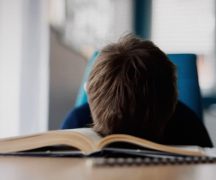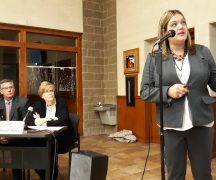By JAN LARSON McLAUGHLIN
BG Independent News
With more than 200 parents and staff watching online Tuesday evening, the Bowling Green Board of Education wrestled with the decision of where the district should go from here with classes.
To get the latest COVID-19 data for the area, Wood County Health Commissioner Ben Robison and BG Schools nurse Brittany Howard attended the virtual meeting.
The district is the only school system in Wood County not holding at least hybrid in-person classes. It’s also the region of the county with the highest numbers of COVID-19 cases.
Superintendent Francis Scruci offered thanks to teachers and parents for their patience with the online start to the school year.
“Their commitment to the profession and students is inspiring,” he said of the teachers.
“Our decision to stay online was difficult,” he said to parents. “It was done with good intentions to keep our students safe.”
Board President Ginny Stewart suggested the board bump up its date to Oct. 8 for deciding whether the district will stay online or offer some form of in-person classes. The board will meet that day at 5:30 p.m.
In preparation for making that decision, the board spent more than an hour Tuesday listening to and asking questions of Robison.
As of today, Wood County has recorded 1,958 COVID cases since March. Eighty people have died from COVID – with 10 of those deaths in the last two weeks. The county currently has 177 active cases – with about 75% of those being in the Bowling Green Zip Codes.
BGSU reported about 120 positive tests in the last couple weeks, with roughly 90% being from off-campus BGSU students. Those college students live in the Bowling Green community. “They shop where we shop. They eat where we eat,” Robison said.
While just 16% of local cases involve people younger than 20, children can pass the virus on to others, he said.
Robison urged the Bowling Green school board to make a decision based on what is best for the district.
“I’ve been in conversations with all the school districts,” he said. “Bowling Green certainly has the opportunity to make decisions based on its own data points.”
“There is no perfect solution,” Robison said. “Recognize that every decision has risks.”
Board members Jill Carr and Norm Geer asked about testing that might be available at the school. Robison said there are three types of tests – with varying levels of accuracy and different return rates. The PRC test is considered the “gold standard” for COVID tests, but the results can take four or five days, he said.
Geer asked about the contact tracing and quarantine process. Robison explained that once a child or teacher tests positive, others who are at risk are identified through contact tracing. Those people must quarantine for 14 days.
Scruci said Bowling Green’s plan calls for mandatory assigned seating in classrooms and on buses – so contact tracing can be more accurate.
The district can greatly minimize the spread of COVID by adhering to its plans for hand hygiene, masks and social distancing, Robison said.
It’s inevitable that schools will see positive cases – through no fault of the districts.
“Schools are going to have cases when there are cases in the community,” Robison said.
But the school’s precautions can make a big difference in limiting the spread, he said.
Stewart pointed out that the district cannot go back to school full-time, and comply with social distancing directives.
“If we go five days a week, we know we cannot provide social distancing in the classrooms,” she said. “Are we asking for trouble going back to four or five days with no social distancing in classrooms?”
Robison said the density of students in classrooms would affect the number of students that would have to quarantine when someone in a class tests positive.
“The approach that you take will be really felt when you have cases in your classrooms,” he said. “There is an inherent risk of going into a congregate setting. The strategies in place can help limit” the spread.
Board member Tracy Hovest asked if the private schools with in-person classes in Bowling Green – St. Aloysius and BG Christian Academy – have experienced COVID cases. Robison said no, but the school numbers are updated every Wednesday.
Stewart also noted that nearly half of the local COVID cases have involved people aged 20 to 50 – the age range of many teachers.
“We have to recognize that COVID plays a risk to all age groups,” Robison said. “I think you are right thinking what this means for your faculty and staff.”
Board member Bill Clifford voiced concerns about providing social distancing on buses.
“Trust me, I want to get back in the classroom,” he said. But the district can’t meet those standards and transport all the bused students every day.
Scruci said with the hybrid model of half the students in school for two days, and the other half for the next two days, that the district should have enough space on buses. The district is not required to transport high school students, but Scruci did not endorse that option.
“That would have a major impact on our families. I wouldn’t recommend it,” he said.
Carr asked Robison how students are managing in school districts that have in-person classes.
“What are you hearing from teachers,” especially for kindergarten through third grade, she asked.
“We’re hearing a range of comments. As kids adapt, they do better at it,” said Robison, who has four children between the ages of 1 and 9. “The more kids do something, the more benign it becomes.”
Stewart expressed concern about Wood County moving up on the state’s list of most cases proportionately. As of today, the county ranked fourth, with 136 active cases for every 100,000 residents.
Robison said he shared those concerns, explaining that if Wood County is pushed into Level Red again, it will be difficult for it to drop back into Level Orange.
School nurse Brittany Howard explained to the board how she handles COVID cases, making sure students quarantine for the correct amount of time and working with the health department. As of Monday’s COVID update from the school district, 12 students were being quarantined for 14 days because they came into close contact during extracurriculars with someone having COVID. Two students who tested positive are in isolation.
“We’re going to do the best we can to protect everyone and keep everyone safe,” Howard said.
The board hired one more nurse during Tuesday’s meeting, but more are needed so there is one nurse in each of the five school buildings.
In response to some parents voicing concerns about the district’s lack of planning for a return to in-person classes, Scruci went through a list of work done at the schools. The list included installation of plexiglass shields in offices and partitions so teacher can do one-on-one work with students, stocking up on masks and face shields, placement of hand sanitizer stations outside every classroom, replacement of water fountains by water bottle refilling stations, training of custodians to clean during the day and at the end of the day, and posting of signs reminding students to wear masks and practice social distancing.
“I can assure you we have prepared to meet our students’ needs,” Scruci said.
Other items in the school district’s plans adopted in July are:
Buildings
● The secondary staff workday will be 7:20 a.m.-3 p.m. Elementary staff workday will be 8:15 a.m. – 3:55 p.m.
● Water bottles will be permitted. Water bottle dispensers will be installed replacing traditional water fountains.
● Upon entering the building, students will be required to go directly to their first period class, homeroom, or grade-level classroom. No congregating in groups in the hallways or outside the building will be allowed.
● No visitors will be permitted in the buildings until further notice.
● No volunteers will be allowed until further notice.
● Students will not be permitted to use lockers in the academic areas of the buildings.
● Masks are required for all staff PK-12 and students K-12 in all common areas and during transitions.
● Fans of any kind are prohibited in classrooms.
● Each building will develop its own dismissal plans based on the uniqueness of each building and grade level.
Transportation
● Students will be assigned specific seats on the bus.
● One student per seat on the bus unless family relation.
● On arrival – students will be dismissed one at a time.
● Masks will be required when being transported by bus K-12.
● No field trips until further notice.
● No Fifth Grade Camp for the 2020-21 school year.
Health and Safety
● Parents will be responsible to take student temperatures and assess at home. If a student has a fever of 100.4 or higher, or other symptoms, he/she must stay home.
● Staff will be responsible to take temperatures and self-assess at home. If a teacher has a fever or shows symptoms, they must stay home.
● All staff PK-12 will be required to wear masks unless for medical reasons, at which time a face shield that extends below the chin is required.
● Students will be required to wear masks in the classroom K-12. If a medical condition exists, students will be required to wear a face shield instead of a mask. Students with disabilities will be considered on an individual basis.
● If a student develops symptoms/fever while at school, they will be placed in the designated isolation room. Parents will be required to pick up their students within 30 minutes.
● Custodians will be sanitizing door handles and other touch points throughout the day in all buildings.
● Recess will be allowed, but children will be required to maintain social distancing.
Classrooms
● Classrooms will be set up to maintain the recommended 6 feet social distancing.
● Mandatory seating assignments will be made in all classrooms so contact tracing could be conducted.
● Students will be required to wear masks in the classroom K-12.
● Students will be permitted to take bookbags in the classroom.
● No fans for air movement or cooling are permitted in the classroom.
● No exhaust fans can be used in labs.
● Desks and tables will be sanitized at the end of each class period at the secondary level, while sanitizing of desks or tables will occur at lunchtime and before dismissal at the elementary level.
● Teachers will maintain a 6 feet social distance during instructional time.
Food Service
● Breakfasts and lunches will be eaten in the classroom unless buildings can create a schedule for small numbers of students to eat in the cafeteria while maintaining 6 feet social distancing.
● Delivered lunches from outside vendors are prohibited for staff and students.
● Lunches will continue to be provided for children at home, though the details of the program have not been ironed out.





